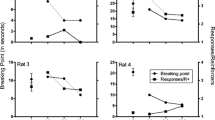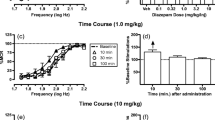Abstract
Caffeine and related alkylxanthines are widely used for recreation and therapeutic effects. In behavioral studies, both response rate-enhancing and attenuating effects have been described, depending upon the dose and behavioral measure used. Intracranial self-stimulation (ICSS) and differential reinforcement of low rates of responding (DRL) were assessed after rats were administered one of a range of doses of caffeine or aminophylline. These measures were chosen because of their demonstrated sensitivity to psychotropic drugs and the potential for comparing the alkylxanthine data to the extensive literature of amphetamine effects on ICSS and DRL behavior. Caffeine and aminophylline elicited dose-and drug-dependent changes in ICSS responding, and increased response rates and decreased reinforcements on the DRL schedule. These behavioral results are discussed with reference to alkylxanthine interactions with adenosine receptors.
Similar content being viewed by others
References
Brecher EM (1972) Licit and illicit drugs. Consumers Union, New York
Kao FT, Puck TT (1969) Genetics of somatic mammalian cells. IX. Quantitation of mutagenesis by physical and chemical agents. J Cell Physiol 74:245–258
Koob GF, Winger GD, Meyerhoff JL, Annau Z (1977) Effects of d-amphetamine on concurrent self-stimulation of forebrain and brain stem loci. Brain Res 137:109–126
Kuroda Y (1978) Physiological roles of adenosine derivatives which are released during neurotransmission in mammalian brain. J Physiol (Paris) 74:463–470
Liebman J, Segal DS (1977) Differential effects of morphine and d-amphetamine on self-stimulation from closely adjacent regions in rat midbrain. Brain Res 136:103–117
Londos C, Cooper DMF, Schlegel W, Rodbell M (1978) Adenosine analogs inhibit adipocyte adenylate cyclase by a GTP-dependent process: Basis for actions of adenosine and methylxanthines on cyclic AMP production and lipolysis. Proc Natl Acad Sci USA 75:5362–5366
Lutz EG (1978) Restless legs, anxiety and caffeinism. J Clin Psychol 39:693–698
McKim WA (1980) The effect of caffeine, theophylline and amphetamine on operant responding in the mouse. Psychopharmacology 68:135–138
Neil JF, Himmelhoch JM, Mallinger AG, Mallinger J, Hanin I (1978) Caffeinism complicating hypersomnic depressive episodes. Compr Psychiatry 19:377–385
Pellegrino LJ, Pellegrino AS, Cushman AJ (1979) A stereotaxic atlas of the rat brain. Plenum, New York
Phillis JW, Edstrom JP, Kostopoulos GK, Kirkpatrick JR (1979) Effects of adenosine and adenine nucleotides on synaptic transmission in the cerebral cortex. Can J Physiol Pharmacol 57:1289–1312
Phillis JW, Kirkpatrick JR (1978) The action of adenosine and various nucleotides and nucleosides on the isolated toad spinal cord. Gen Pharmacol 9:239–247
Snyder SH, Katims JJ, Annau Z, Bruns FF, Daly JW (1981) Adenosine receptors and behavioral actions of methylxanthines. Proc Natl Acad Sci USA 78:3260–3264
Stillner V, Popkin MK, Pierce CM (1978) Caffeine-induced delirium during prolonged competitive stress. Am J Psychiatry 135:855–856
Swensson E, Persson LO, Sjoberg L (1980) Mood effects of diazepam and caffeine. Psychopharmacology 67:73–80
Van Calker D, Muller M, Hamprecht B (1978) Adenosine inhibits the accumulation of cyclic AMP in cultured brain cells. Nature 276:839–841
Wayner MJ, Jolicoeur FB, Rondeau DB, Barone FC (1976) Effects of acute and chronic administration of caffeine on schedule-dependent and schedule-induced behavior. Pharmacol Biochem Behav 5:343–348
Webb D, Levine TE (1978) Effects of caffeine on DRL performance in the mouse. Pharmacol Biochem Behav 9:7–10
Author information
Authors and Affiliations
Rights and permissions
About this article
Cite this article
Valdes, J.J., McGuire, P.S. & Annau, Z. Xanthines alter behavior maintained by intracranial electrical stimulation and an operant schedule. Psychopharmacology 76, 325–328 (1982). https://doi.org/10.1007/BF00449119
Received:
Accepted:
Issue Date:
DOI: https://doi.org/10.1007/BF00449119




